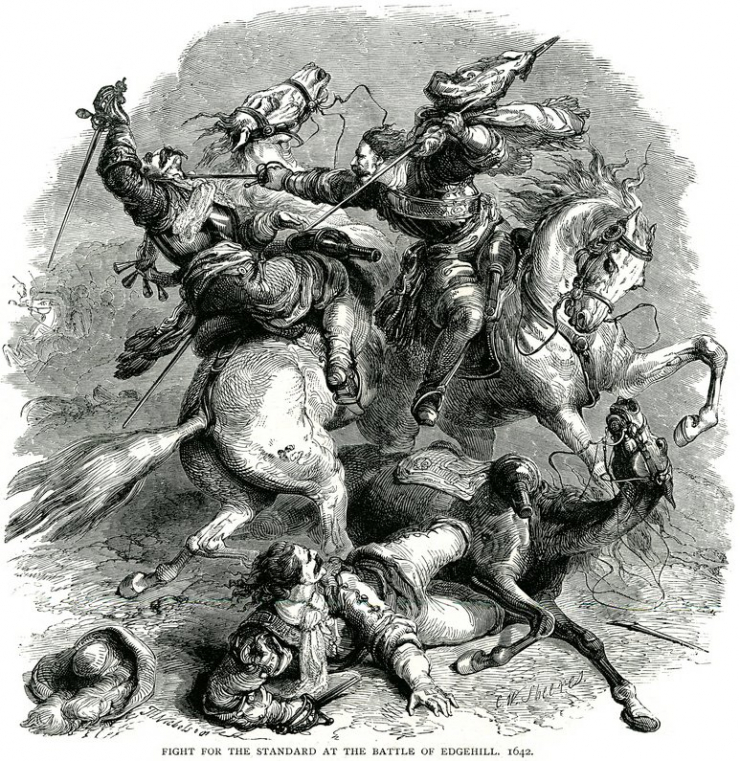
The Battle of Edgehill was the first major conflict of the English Civil War, taking place on the fields of Warwickshire. But after the armies departed, the villagers continued to be haunted by spectres and apparitions. The ghosts were recorded by Charles’ officers, and are the only ones to be officially recognised by the British Public Record Office.
The Battle of Edgehill was fought on 23 October 1642. After the fighting, the Parliamentarians retreated to Warwick, and the Royalists made tracks south, but failed to monopolise on the open road to London. Edgehill was not the decisive, one-off battle everyone had hoped for. It was the start of a long slog of years of war, tearing the fabric of Britain apart.
 Watch Now
Watch NowThe Earl of Essex and Charles I may have moved on, but they left behind a trail of bloodshed and upheaval. Corpses which littered the fields were tossed into mass graves. For those who survived, they were pretty much ruined, becoming dependent on local charity. One Royalist’s account of Kineton stated: “the Earle of Essex left behind him in the village 200 miserable maimed solders, without relief of money or surgeons, horribly crying out upon the villainy of those men who corrupted them.”
“They Could Not Believe They Were Mortal”
But the horrors of Edgehill didn’t end there. A report was commissioned by Charles I, to report on the remarkable rumours which had reached him:
“On Saturday, which was in Christmas time . . . between twelve and one of the clock in the morning, was heard by some shepherds first the sound of drums afar off and the noise of soldiers giving out their last groans; at which they were much amazed, and amazed stood still, till it seemed by the nearness of the noise to approach them; at which, too much affrighted, they sought to withdraw as fast as possibly they could.”
But then a great vision filled the sky “of strange and portentous apparitions of two jarring and contrary armies – the same incorporeal soldiers that made those clamours, the clattering of arms, noise of cannons, ensigns displayed, drums beating, muskets going off, cannons discharged, horses neighing, cries of soldiers, and the two armies – pell-mell to it they went. So amazing and terrifying the poor men, that they could not believe they were mortal, or give credit to their eyes and ears; run away they durst not, for fear of being made a prey to these infernal soldiers, and so they, with much fear and affright, stayed to behold the success of the business.”

The Edgehill battlefield, where the spectres appeared.
After three hours of fighting the apparitions vanished into the night sky. “The shepherds made haste to Kineton, where they woke up Mr. Wood, a Justice of Peace, and his neighbour, Mr. Marshall, the Minister.”
“Those hellish and prodigious enemies”
“The following night, all the substantial inhabitants of that and the neighbouring parishes drew thither; where, about half an hour after their arrival, on Sunday, being Christmas night, appeared in the same tumultuous warlike manner, the same two adverse armies, fighting with as much spite and spleen as formerly; and so departed the gentlemen and all the spectators, much terrified with these visions of horror, withdrew themselves to their houses, beseeching God to defend them from those hellish and prodigious enemies.”
Over the coming weeks, there were so many sightings by the villagers of Kineton that news of the spectres reached King Charles, who was based in Oxford. A Royal Commission of 6 officers were informed to “report upon these prodigies, and to tranquillise and disabuse the alarms of a country town”.
But on visiting the battlefield, the officers who had fought at the battle confirmed the apparitions, and even identified some of the soldiers. They saw Sir Edmund Verney, the king’s standard bearer. During the battle, it’s said the Parliamentarians chopped his hand off in order to obtain the Royal Standard, which, when recovered by the Royalists, was said to still have Sir Edmund’s dismembered hand clinging on.

The officers confirmed the visions, and even recognised the figure of Sir Edmund Verney, the king’s standard bearer. (Image Source: Alamy)
The officers drew up this report, named ‘A Great Wonder in Heaven, showing the late apparitions and prestigious Noises of the War and Battles, seen at Edgehill, near Kineton’. Ever since it was published on 23 January 1643, the Edgehill phantoms are the only ghosts to be officially recognised by the British Public Record Office.
According to those 6 officers, the phantoms were a divine omen: “doubtlessly it is a sign of His wrath against this land, for these civil wars.”
With bodies still littering the battlefield, locals from nearby villages apparently set about retrieving them, giving each a Christian burial so that their souls may find peace. The tirade of apparitions then supposedly ceased, however many since have reported hearing cannon fire, battle cries and horses’ hooves echoing over the old battlefield, particularly around the anniversary of the event.














